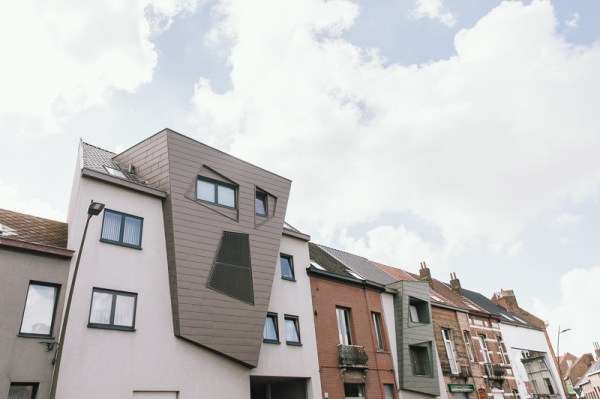W
elcome to the TechCrunch Exchange, a weekly startups-and-markets newsletter. It’s inspired by the daily TechCrunch+ column where it gets its name. Want it in your inbox every Saturday? Sign up here.
This week, some thoughts on AI aesthetics, the challenge of uninsurability, and how to pitch a biotech startup to non-experts. — Anna
Too good to be true
Most tools claiming to detect AI-generated text fail spectacularly, my colleague Kyle Wiggers reported. That’s a paradox. I’m only human, but a lot of the AI-written pitches I receive don’t pass the sniff test yet; their style and wordiness feel off.
Then again, it is probably too early to expect machines to detect a je ne sais quoi, even if we can see it. As fellow TechCrunch writer Ron Miller observed recently, “it’s really like AI-generated art, which has a certain look and feel.”
That look and feel was made funnily obvious in a recent experiment conducted on one of my favorite social media accounts, Ugly Belgian Houses.
Led by creative agency owner Hannes Coudenys, this project became cult — and turned into two books and a TV show — for showing exactly what its name suggests. But in a break from his usual posting, Coudenys decided to give generative AI a spin. As he told me:
First I went looking for real estate agents that use a lot of [waffle] to sell a house. Searching for keywords like unique, dream house, pearl. And then I had to filter them to find the ugly ones.
When I found those I fed the exact text to ChatGPT and asked: Make me an image for this text.
I was amazed that the results came out crazy perfect from the first try.
You could call it perfect . . . or hilarious: The contrast between reality and what the AI created based on the description is painfully obvious.
Does that mean we are stuck with AI aesthetics that are disconnected from reality and, say, overly optimistic like only real estate agents can be? Probably not; it depends on what we feed them, and Coudenys saw firsthand that AI can do ugly, too, if you insist.
“I’ve tried DALL-E before to create Ugly Belgian Houses. And the funny thing is, since I’ve been doing UBH for 10 years, DALL-E knows the style and got some amazing results. I even posted them. In this post I said it was AI. In this one I didn’t, and people just believe it’s true. Felix Da Housecat even commented,” Coudenys told me.
One thing is for sure: With or without AI, I agree with Coudenys that Ugly Belgian Houses is a gift that keeps on giving.
Insurability and Luko’s epilogue
Luko’s roller-coaster ride and urgent search for a buyer finally came to an end when news emerged that Allianz Direct would buy the French insurtech startup for €4.3 million (around $4.65 million), enabling business to continue and jobs to be maintained.
Court documents reveal that Luko’s suitors also included several other insurtech startups: Laka, Leocare, Lovys and Magnolia. French neoinsurer Leocare, in particular, was willing to take over at least 26 of Luko’s employees and all of its French home insurance business, but its €10 bid was no rival for Allianz Direct’s final offer.
However, Leocare CEO Christophe Dandois is no sore loser. In a post on LinkedIn, he wished his competitors good luck while recapping their journey and what could have been. Sure, mistakes were made, but both founding teams shared a desire to bring solutions to the growing challenge of insurability.
Insurability wasn’t a term I was very familiar with, but many of us intuitively understand what’s at play: Risk exposure is a fine balance for insurers. With factors such as more frequent weather and climate hazards, or even simply societal changes like remote work and new forms of mobility, Dandois explained, there’s a time when it just becomes too much to insure risks the old way, at least affordably.
Still, I wondered what this had to do with selling home insurance in France, like Luko and Leocare do. But reading more on the topic, I realized that this was more than a thought exercise.
“While France has yet to share the fate of the United States, where insurers are withdrawing en masse from certain regions exposed to natural disasters,” French newspaper Les Echos noted recently, “the phenomenon is already visible in the French overseas territories, where property insurance coverage stands at 50%, compared with 96% in mainland France.”
Hence Dandois’ view, which is both moderate and bold: “Neoinsurers aren’t the only future of insurance, but without their digital and APIzation know-how, without their ability to deploy quickly and make data speak, there will be no social and societal answer to THE question of insurability.” A worthy challenge for tech to take on.
Pepper Bio’s pitch deck teardown
It is always intimidating to write about biotech as a non-expert. But when I recently covered Pepper Bio’s seed round, chief scientific officer Samantha Dale Strasser and CEO Jon Hu did a great job at explaining what they do to the layperson that I am. I didn’t know what transomics meant beforehand, but after our chat, I could grasp how it could help discover drugs for untreated diseases such as certain forms of cancer.
Did Pepper Bio strike the same balance in its pitch deck, which my colleague Haje dissected for his Pitch Deck Teardown series? Yes and no. One slide required a lot of guesswork or previous knowledge of the drug discovery space. But Haje had big kudos for other slides, calling one “a masterpiece” and another one a “mic drop.” Well done, Pepper Bio.
